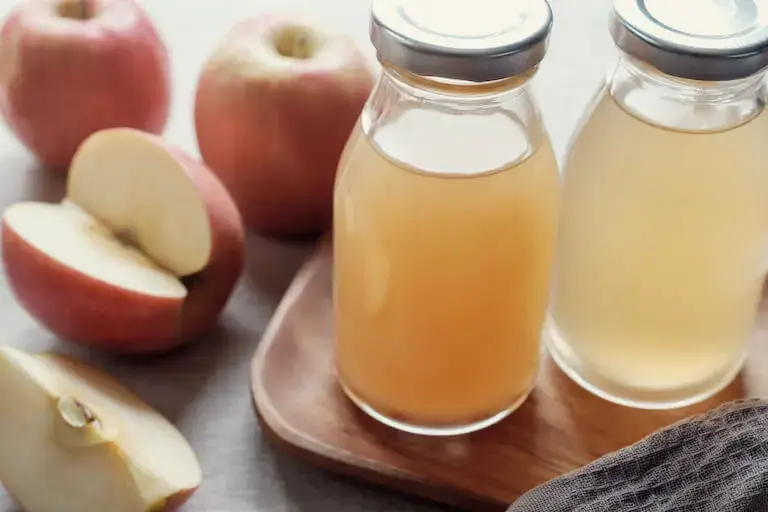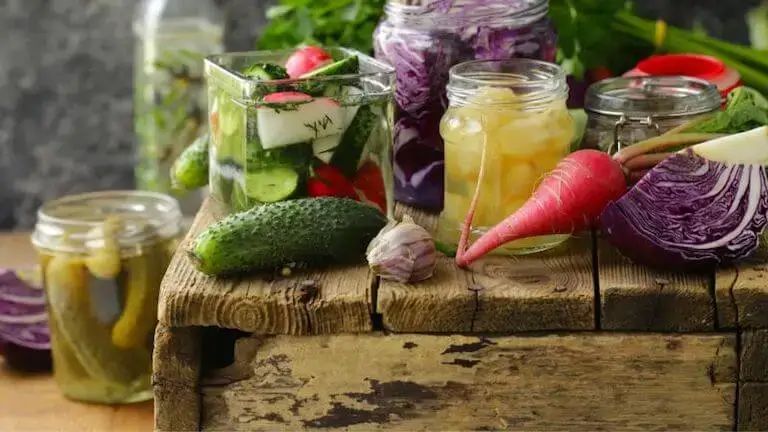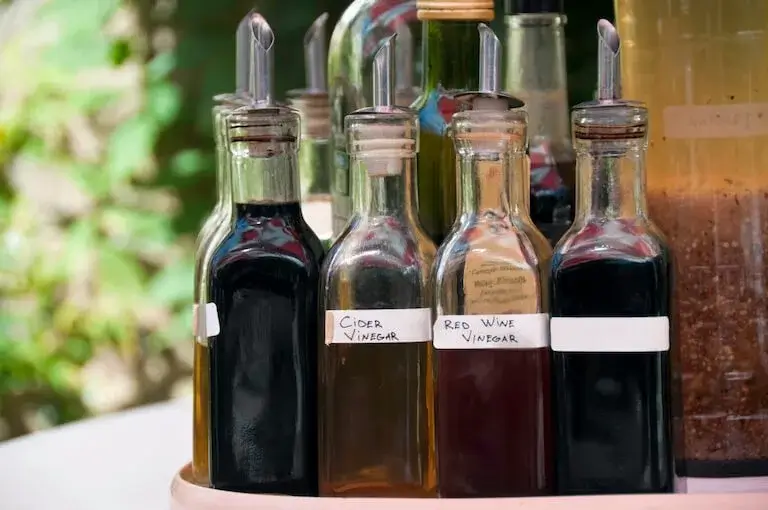Listen to This Article:
Vinegar doesn’t always get the attention it deserves. It sits quietly in the pantry, often overlooked, yet it can be one of the most powerful ingredients a cook can reach for. It can brighten a heavy dish, soften tough cuts of meat, or bring balance to something that tastes just a little too sweet. In the hands of someone who knows how to use it, vinegar can take a good dish and make it memorable.
“I love pickling, preserving, and finding ways to fully utilize a product or ingredient,” says Pastry Arts Chef Instructor Erin Kanagy-Loux. “So if I pickled blueberries in champagne vinegar for a dessert and was only using the berries, I could take the strained vinegar and reduce it down with sugar to make a gastrique, I could use it in a vinaigrette, I could use it to (provide) balance in a cocktail, or add it to a sorbet… the possibilities are endless!”
In this guide, you’ll learn how vinegar forms, explore the most common types used in the kitchen, and discover how to use it to enhance your cooking. Whether you’re beginning your culinary education or sharpening your technique, vinegar is one ingredient that can transform your cooking.
What Is Vinegar and How Is It Made?
Vinegar is a tangy liquid made through a natural fermentation process. It starts with a sugary or starchy liquid—like fruit juice, wine, or grain-based alcohol—that goes through two main steps:
- First, sugar turns into alcohol.
During a process called alcoholic fermentation, yeast eats sugars and produces alcohol, like in wine or beer. - Then, the alcohol turns into acid.
In the second step, called acetous fermentation, a unique bacterium (called Acetobacter) converts the alcohol into acetic acid, which gives vinegar its sour taste.
The base ingredient used in the process, like apples, grapes, rice, or malted barley, determines the type of vinegar and its unique flavor. For example, apples produce apple cider vinegar, while red wine becomes red wine vinegar. Most culinary vinegars have an acidity level between 4% and 7%, making them strong enough to preserve food and enhance flavor without overpowering when used correctly.
Some vinegars, particularly those that are raw or unfiltered, contain something called the “mother” of vinegar. It’s a harmless, jelly-like substance made of natural bacteria and enzymes. The “mother” is typically safe to consume and a sign the vinegar is still alive and unpasteurized.

Apple cider vinegar is made by fermenting apple juice into alcohol and then into acetic acid.
Common Types of Vinegar and Their Flavor Profiles
The base ingredient used to make vinegar—whether apples, grapes, grains, or rice—significantly impacts its taste, aroma, and best culinary uses. Some vinegars are sharp and bold, while others are sweet and mellow. Knowing which vinegar to use can help you better balance flavor and create more intentional dishes.
The table below breaks down some of the most commonly used vinegars in cooking, their flavor profiles, and where they shine in the kitchen:
| Type of Vinegar | Base Ingredient | Flavor Profile | Common Uses |
|---|---|---|---|
| White Distilled | Grain Alcohol | Sharp, neutral | Pickling, cleaning, baking |
| Apple Cider | Fermented apple juice | Fruity, tangy, slightly sweet | Dressings, marinades, health-focused recipes |
| Balsamic | Grape must (crushed grapes with skins, seeds, and stems) | Sweet, rich, syrupy with a tangy bite | Drizzling, glazes, roasted vegetables, desserts |
| Red Wine | Red wine | Bold, acidic, slightly fruity | Vinaigrettes, sauces, braised meats |
| White Wine | White wine | Milder than red wine vinegar, lightly fruity | Cream sauces, fish, salad dressings |
| Rice | Fermented rice | Mild, slightly sweet | Stir-fries, sushi rice, dipping sauces |
| Malt | Malted barley | Malty, toasty, mildly sweet | Fish and chips, English-style dishes |
| Sherry | Sherry wine | Nutty, complex, medium-bodied | Spanish dishes, glazes, vinaigrettes |
| Champagne | Champagne | Light, crisp, delicate | Seafood, light dressings, beurre blanc |
Specialty, Infused, and Seasoned Vinegars
Beyond the everyday options, a wide variety of specialty and infused vinegars are available, made with ingredients like:
- Fruits (e.g., raspberry, fig, blueberry)
- Herbs and spices (e.g., tarragon, garlic, chili)
- Unique bases (e.g., coconut sap, sugar cane)
These vinegars tend to have more pronounced or niche flavor profiles, and chefs often use them as a finishing touch in gourmet salad dressings or custom sauces. They can add depth or unexpected flair to a dish and are especially useful for chefs looking to create signature flavors.
For example, a raspberry-infused vinegar can add a tart-sweet twist to a vinaigrette made with olive oil, Dijon mustard, and honey, great for pairing with mixed greens and goat cheese.
Seasoned vinegars, generally made from rice vinegar, are typically pre-mixed with sugar and salt. Japanese and other Asian cuisines often feature these vinegars in dishes like sushi rice, dipping sauces, and quick pickles. These vinegars save time and help ensure consistent flavor in recipes that call for a balance of sweet, salty, and acidic notes.
Other vinegars are made from unique bases, like coconut sap, sugar cane, or honey. These types of vinegar offer additional layers of flavor and can be ideal for experimentation or regional recipes. Coconut vinegar is used in popular Filipino recipes like adobo dishes, while cane vinegar adds mild acidity to Caribbean and Latin American recipes. These can help add depth to a dish while also connecting it to the culinary traditions that shaped it.
Culinary Uses for Vinegar
Vinegar does more than add a tangy kick to your meals. It can tenderize meat, preserve produce, and contribute to chemical reactions in baking. For example, the secret weapon of authentic red velvet cake is vinegar, which reacts with baking soda to help the cake rise and enhance its red color.
Knowing how and when to use vinegar can change the way you cook. Here are some of the most common ways to use vinegar in cooking:
Flavor Balancer
Vinegar’s acidity can help bring balance to overly sweet or rich dishes. A small amount can add contrast and round out flavors without being overpowering.
- Add a dash to creamy soups or sauces to brighten the flavor.
- Use in fruit-based dishes or desserts to bring out natural sweetness.
- Balance heavy ingredients like cheese, butter, or fatty meats.
Marinades and Tenderizers
Vinegar breaks down the surface of proteins, making it an effective tool for tenderizing meat and enhancing flavor penetration in marinades.
- Works well with tougher cuts of meat or plant-based proteins
- Combine with herbs, spices, and oils to create balanced marinades.
- Avoid over-marinating, as too much acidity can turn meat mushy.

Vinegar can help break down proteins in meat, making it more tender.
Dressings and Vinaigrettes
Vinegar is the foundation of many salad dressings. Its acidity cuts through oil and helps emulsify ingredients.
- Start with a basic 3:1 oil-to-vinegar ratio and adjust based on taste.
- Choose complementary pairings of oils and herbs, such as balsamic with olive oil and basil.
- Whisk in mustard or honey to help emulsify and add complexity.
Pickling and Preserving
Vinegar is a natural preservative, used in both quick and fermented pickling methods. Its high acidity helps prevent spoilage and enhances flavor.
- Use white distilled vinegar for a clean, sharp taste.
- Try rice vinegar or apple cider vinegar for a softer, slightly sweet finish.
- Choose vinegar with 5% acidity for safe and effective results.

Pickling with vinegar preserves vegetables like cucumbers, cabbage, and radishes while enhancing their flavor and extending shelf life.
Deglazing and Reductions
Vinegar can deglaze a pan after food has been seared, creating the base of rich sauces. When reduced, it can also add a syrupy finish.
- Use red wine vinegar or sherry vinegar for savory pan sauces.
- Reduce balsamic vinegar into a syrupy glaze for vegetables, meats, or even desserts.
- Stir in butter or stock to round out sharpness in reductions.
- Make a gastrique by reducing vinegar with sugar or fruit juice for a sauce that is classically served with dishes like Duck à l’Orange but can also be delicious with plated desserts.
Baking Uses
Vinegar reacts with baking soda to create carbon dioxide, which helps batters rise. It also adds subtle tang and can replace eggs or buttermilk in some recipes. And because of its denaturing properties, white distilled vinegar can be used to rinse a mixing bowl and whip attachment to help clear them of fat and strengthen egg whites while whipping a meringue (or even added to the whites while whipping).
- Use in vegan recipes as an egg replacer.
- Make quick buttermilk by mixing 1 tablespoon white vinegar with 1 cup of milk.
- Add a small amount to red velvet or chocolate cake for enhanced rise, color, and flavor.
Tips & Techniques for Cooking with Vinegar
Once you understand the what and why of vinegar, the next step is learning the how. Using vinegar well is all about balance, timing, and choosing the right type for the job. Here are some essential tips and techniques to help you make the most of this powerful ingredient in your cooking.
1. How to Balance Acidity
Vinegar is strong by nature—too much can overpower a dish. The key is to start small and taste as you go. A teaspoon might be all you need to brighten a sauce, soup, or stew. Balance is important because acidity should help enhance, not dominate.
Tip: If you accidentally added too much vinegar, use honey or sugar to add sweetness to the dish or a fat like cream or olive oil to help balance it.
2. Pairing Vinegar with Oils, Herbs, and Spices
Vinegar pairings should complement or contrast with the other ingredients to create balance and depth. Knowing what flavors work well together can help you make more intentional choices in your cooking.
- Balsamic pairs well with berries, roasted vegetables, and herbs like thyme.
- Rice vinegar works beautifully with sesame oil, soy sauce, and ginger.
- Red wine vinegar shines with garlic, oregano, and hearty greens.
Tip: When in doubt, match the vinegar’s origin to the cuisine—for example, rice vinegar for Asian dishes like ramen, or sherry vinegar for Spanish fare.
3. Choosing the Right Vinegar for the Job
Each vinegar brings a different character to a dish. Use bold vinegars when you want to make a statement, and milder ones when the goal is subtle enhancement.
Some vinegars also come in different ages and grades, with older versions offering deeper, more concentrated flavor. With balsamic vinegar, for example, you can buy a very low grade that’s as loose as water and has a very sharp, tannic balsamic flavor. Or you can buy “authentic balsamic,” which must be aged for a minimum of 12 years and has a thick, syrupy, almost molasses-style texture with a taste that is almost sweet with a rich, deep balsamic flavor.
- White distilled vinegar is sharp and neutral—ideal for pickling or cleaning, but rarely used for flavoring on its own.
- White wine or rice vinegars are light and delicate, perfect for seafood dishes or simple vinaigrettes.
- Balsamic vinegar is rich, sweet, and complex—great for glazes, roasted vegetables, or drizzling over salads and fruits.
Tip: Keep at least two or three types of vinegar in your pantry so you have options to suit different recipes and cuisines.

Choosing the right vinegar depends on the dish—each type brings a unique flavor profile that can enhance or overpower your ingredients.
4. When to Add Vinegar in Cooking
The point at which you add vinegar during cooking can affect how it changes the flavor of the dish. Vinegar’s acidity changes depending on whether it’s cooked or added at the end, so it’s important to consider your goal. Here are some rules of thumb for timing:
- Added early in cooking: The sharpness softens, and the vinegar blends into the background, adding depth without overpowering.
- Added at the end of cooking: The acidity stays bright and noticeable, giving a dish a final punch of flavor—great for soups, sauces, and braises.
- Raw applications: The strength of the vinegar comes through, which can be ideal for dressings, slaws, quick pickles, or dipping sauces.
- Finishing vinegars: An aged vinegar, like a thick and syrupy balsamic, can make a divine drizzle or finish for a Roquefort blue on a cheese plate or can be used to toss fresh cherries and plated with cheesecake.
“Another fun way to layer flavors and bring depth to a dish is to infuse vinegar,” says Pastry Arts Chef Instructor Erin Kanagy-Loux. “It’s fairly quick and a great way to sass up a cheaper vinegar. I also love vinegar pickling, drizzle finishing, and saucing desserts. Vinegar isn’t only used for chemical reactions in the pastry and baking world!”
You can make an infused vinegar by sterilizing a jar, warming your chosen vinegar to just below the boiling point, adding your flavorings, then sealing the jar and refrigerating (after the jar has cooled).
Tip: Add vinegar at the end of cooking if you want to “wake up” a dish that tastes flat or heavy—it can give an instant lift and balance.
FAQs About Cooking with Vinegar
Can I substitute one type of vinegar for another?
Yes, but with caution. While you can often substitute vinegars, the flavor and acidity can vary greatly. For example, swapping balsamic for white vinegar will drastically change the taste of a dish.
If you’re unsure, try mixing a milder vinegar with a touch of sweetness to approximate bolder options like balsamic.
What’s the shelf life of vinegar?
Most vinegars last indefinitely, especially if stored in a cool, dark place. Over time, they may lose some potency or develop slight changes in appearance, but they generally don’t spoil. One exception is an infused vinegar, which should be stored in the refrigerator to prevent unwanted bacterial growth.
Is vinegar gluten-free?
Most vinegars are gluten-free, including white, wine, rice, and apple cider vinegar. Malt vinegar, however, is made from barley and contains gluten unless specifically labeled gluten-free.
Why does my vinegar have sediment or a “mother”?
That cloudy stuff floating in the bottle is called the mother of vinegar, made of natural bacteria and cellulose from the fermentation process. You can consume it and often find it in raw or unfiltered vinegars like apple cider vinegar. If you prefer a clear vinegar, strain it through a coffee filter or cheesecloth before using.
What’s the difference between cleaning vinegar and cooking vinegar?
Cleaning vinegar usually has a higher acidity (around 6%) and may contain additives that aren’t food-safe. It’s meant for disinfecting surfaces and not for consumption. Always look for “food-grade” or “for culinary use” on the label if you plan to use vinegar in recipes.
Elevating Your Culinary Skills with Vinegar
Vinegar may seem like a simple ingredient, but using it well is a sign of a thoughtful and skilled cook. It is not just about adding sourness but about brightening flavors, building depth, and balancing acidity, sweetness, salt, and fat.
At Auguste Escoffier School of Culinary Arts, students can explore how to use ingredients like vinegar with intention and creativity. Through hands-on training and real-world experience, they can gain the confidence to build flavor and understand the science behind each culinary decision.
Escoffier offers culinary arts programs to help you build a strong foundation in technique, flavor development, and ingredient knowledge, whether you are just starting or looking to grow your skills.
Contact us to see how a culinary education can help you grow as a cook and take your career to the next level.
IF YOU’RE READY TO CONTINUE GROWING YOUR CULINARY KNOWLEDGE, CHECK OUT THESE ARTICLES NEXT!
- How to Make the 5 Mother Sauces
- 7 Substitutes for All-Purpose Flour
- Chef Albert Schmid Shows That a Culinary Career is Yours to Write
*Information may not reflect every student’s experience. Results and outcomes may be based on several factors, such as geographical region or previous experience.
This article was originally published on January 13, 2016, and has since been updated.

